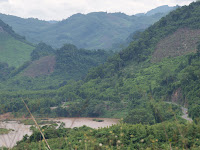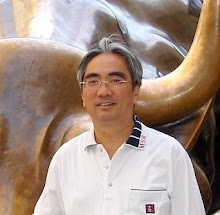Oudomxay’s proximity to China has brought the province rapid economic growth and
 infrastructure developments, including good road access to the provincial capital, Xay District (except from Na Maw to Xay). Xay District is the natural stop for
infrastructure developments, including good road access to the provincial capital, Xay District (except from Na Maw to Xay). Xay District is the natural stop for  Chinese tourist heading for Luang Prabang or Vientiane and Thai tourist from Huay Xai to Vientiane. There is nothing much to see in this provincial capital. Tourism business was affected. The hotel we stayed in was built a year ago. It has on the skeleton staff manning. The manager, William, Malaysian, told us that their low season occupancy rate is below 20%. Most of the hotels here are catered for Chinese coming from Yunnan province. The border town Boten is only 2 hours by car from Xai District.
Chinese tourist heading for Luang Prabang or Vientiane and Thai tourist from Huay Xai to Vientiane. There is nothing much to see in this provincial capital. Tourism business was affected. The hotel we stayed in was built a year ago. It has on the skeleton staff manning. The manager, William, Malaysian, told us that their low season occupancy rate is below 20%. Most of the hotels here are catered for Chinese coming from Yunnan province. The border town Boten is only 2 hours by car from Xai District.This lady balanced herself on the back of motorcycle with her child on one side and her handbag  on the other side.
on the other side.

 on the other side.
on the other side.
Kids were sitting around and watching car went by

A haircut for free here, any taker?

 We saw a minority lady coming down the steep slope of the hill with a heavy basket on her back. About 10 minutes later, she arrived at the roadside store, about 500 meters away. Tough life!
We saw a minority lady coming down the steep slope of the hill with a heavy basket on her back. About 10 minutes later, she arrived at the roadside store, about 500 meters away. Tough life!
We decided to contribute to the local economy by buying cucumbers as our afternoon snack when we are on the road. We had consumed almost all the food we brought from home.
 The road leading to Luang Prabang skirting around the mountains. Many parts of the road were managed due to heavy rain last October. Now, raining season started again. In some sections, the
The road leading to Luang Prabang skirting around the mountains. Many parts of the road were managed due to heavy rain last October. Now, raining season started again. In some sections, the  road was reduced to one lane. Land slide is still happening. This huge stone actually came down the hill a couple of days ago and blocked the road. Luckily, no car was hit by these rocks.
road was reduced to one lane. Land slide is still happening. This huge stone actually came down the hill a couple of days ago and blocked the road. Luckily, no car was hit by these rocks.Luang Prabang

 We finally arrived Luang Prabang around 3 pm. After some searching around, There are many guesthouses to suit everyone taste and budget. We ltook our time to look at below before wewe settled into this Ramayana boutique hotel for the next 3 days.
We finally arrived Luang Prabang around 3 pm. After some searching around, There are many guesthouses to suit everyone taste and budget. We ltook our time to look at below before wewe settled into this Ramayana boutique hotel for the next 3 days.


Royal Palace Museum
The Royal Palace Museum was built about 105 years ago in 1904 during the early French colonial era as a residence for King Sisavang Vong and his family. On the right hand side of the entrance, within the Royal Palace compound, is Wat Pha Bang, built in 1993. Directly opposite Wat Pha Bang stands the statue of King Sisavang Vong



Phu Si



Phu Si
 Across the road, opposite the entrance of the Royal Palace Museum, there is a hill. Atop of the hill, there are temples recently constructed, but it is likely there were other temples located on this important hill site. On the lower slope, there were two of the oldest (and now abandoned) temples of Luang Prabang.
Across the road, opposite the entrance of the Royal Palace Museum, there is a hill. Atop of the hill, there are temples recently constructed, but it is likely there were other temples located on this important hill site. On the lower slope, there were two of the oldest (and now abandoned) temples of Luang Prabang.The steps leading to the top of the 100-meter hill are broken up into two section. The first 138 steps ended at the ticketing office. The sign on the steps indicated 190 steps going to the top. No choice lah! The views were superb on the top of the hill. You can see the airport, Mekong river and Nam Khan river for here.
Monks procession collecting food
The moon was still hanging in the sky but the streets of Luang Prabang were bustlng with people. This was 5.30 in the morning. The devotees were lined up patiently wating for the monks. Every morning, the monks would go around the city collecting food offered by devotees. The monks from the temples moved in single file. They have a container with a cover. As they walked pass the devotee, they flipped open the cover for the devotee to place their offering inside and they covered it. The procession moved swiftly and silently passed the devotees. It was a serious ritual. 

Boat trip on Mekong to Pak Ou Cave
 We took a boat tour at the Mekong river. All tourists gathered around the jetty waiting to be assigned to different boat. Pak Ou Cave is about
We took a boat tour at the Mekong river. All tourists gathered around the jetty waiting to be assigned to different boat. Pak Ou Cave is about  25 km away. Along the way, we visited a minority village where they shown how rice wine is made.
25 km away. Along the way, we visited a minority village where they shown how rice wine is made.Ban Xang Hai Village





Pak Ou Cave
By the 16th century, Buddhism had been adopted by the royal families of Lao and the caves received patronage from that time until 1975. Every yer the King and the people of Luang Prabang made a pilgrimage to the caves as part of the New Year religious observances. More than 4,000 sclptures of Buddha now found in the caves. These Buddha were placed there by worshippers.



Night Market














No comments:
Post a Comment